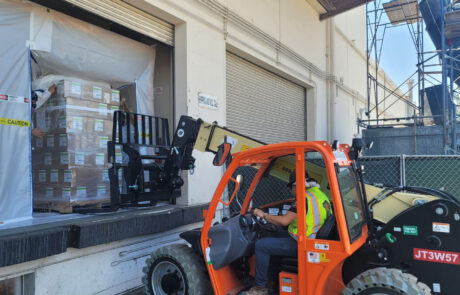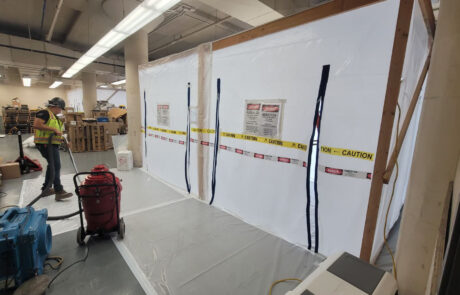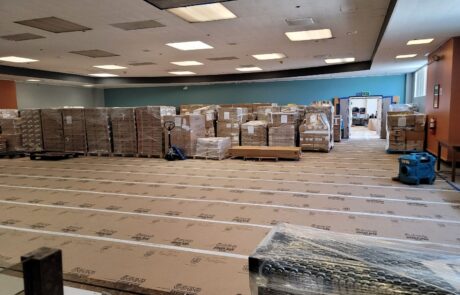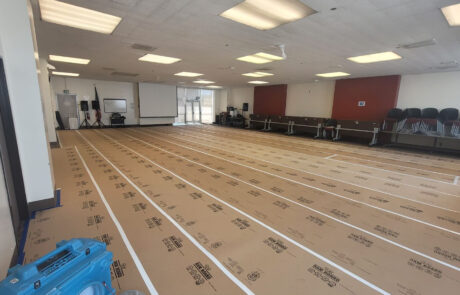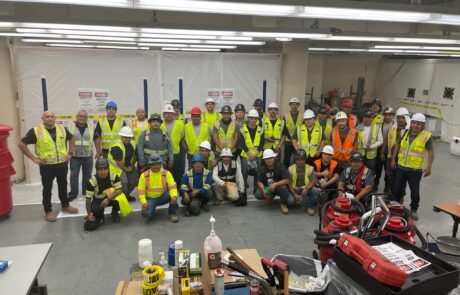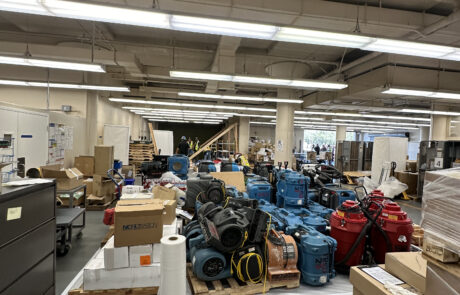COMMERCIAL
Commercial Warehouse / Emergency Asbestos, Mold & Restoration
Commercial Warehouse / Emergency Asbestos, Mold & Restoration
ASBESTOS EMERGENCY CLEAN UP, WATER DAMAGE & MOLD REMEDIATION
The building owner had identified asbestos contamination inside the office spaces in a 200,000 square feet building. The building had been evacuated due to asbestos contamination. The building had a warehouse full of products, electronics and equipment valued at a few million dollars that needed decontamination for it to be used. Additionally, the building faced significant water damage across the first, second, and basement floors. This extensive water intrusion posed both health and safety risks and possible damage to the items stored in the warehouse. This project required a coordinated response to prevent further damage and ensure the property’s safe restoration. The complexity of the job was heightened by the need for full warehouse decontamination and adherence to environmental regulations.
In response, we designed a comprehensive solution that included the following:
- Containment & Initial Assessment:
Upon arrival, we conducted a thorough inspection to determine the extent of the damage. We set up containment zones across all affected floors, isolating the areas to prevent the spread of contaminants and maintain a safe working environment.
- Water Damage and Mold Remediation:
Crews installed water extraction equipment throughout the building to dry out all surfaces impacted by the water intrusion. Removed all mold infested miscellaneous materials and walls and finished to completely remove the mold infestation. After passing clearance testing, all equipment and contaminants were removed.
- Procedure 5 Abatement Execution:
Following the initial assessment, our certified team executed a Procedure 5 abatement process in full compliance with SCAQMD (South Coast Air Quality Management District) guidelines. This involved air quality control, dust mitigation, and the safe removal of hazardous materials, all while adhering to the building consultant’s outlined procedures.
- Decontamination Process:
After the abatement, we initiated a detailed decontamination of the facility, focusing on removing waterborne contaminants and preventing mold growth. Specialized equipment and treatments were used to restore the building’s air quality and ensure the space was safe for occupancy.
- Products, Electronics and Equipment:
Abatement crews built 3 large size decontamination and 2 stage chambers; each was constructed from wood framing, 6 mil poly, and HEPA filtration units; each chamber large enough to hold 6 pallets of product. Our crews would bring the product into the first chamber to inventory, record (pictures) and decontaminate. Then the product was moved to the next clean chamber for repackaging, wrapping and labeling to include a future storage location for easy access by the owner. Then the clean inventoried pallets were transported to a decontaminated area, set as a new storage space. A full inventory report was turned in to the owner to include daily reports, videos and pictures.
- Final Inspection & Restoration:
With the remediation completed, we performed a final clearance testing for Mold and Asbestos and conducted an inspection alongside the client and consultant to confirm that all environmental standards had been met. We also provided the client with recommendations for any necessary structural repairs to fully restore the facility.
This comprehensive approach allowed us to address the water damage efficiently, comply with all necessary regulations, and deliver a fully restored and safe environment for the client.

